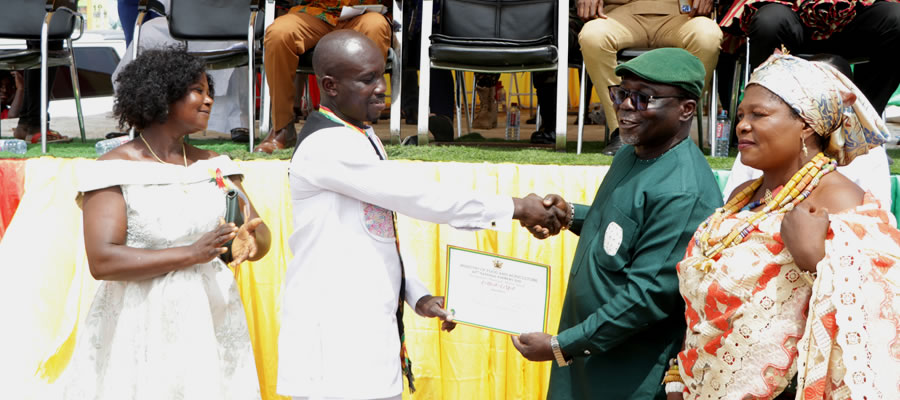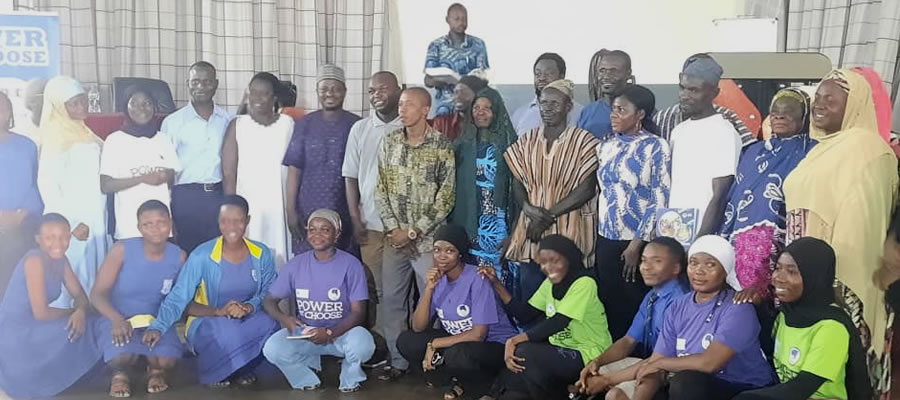

Introduction
The welfare of the people, the community and the nation can be better understood in the light of the household groups and their characteristics, marital status, nationality, religious affiliation, literacy and educational status. This chapter discusses the household size, household composition and headship, marital status, nationality, religious affiliation, literacy and educational status of the population of Ashaiman Municipality.
Household Size, Composition and Headship
The size, structure and composition of households are influenced by social, economic and demographic factors while the total size of a population and its characteristics are in effect largely a reflection of what pertains at the household level.
Table 3.1 provides information on household size in the municipality. The municipality has an average household per house of 2.9 and an average household size of 3.7, less than the regional average household size of 3.8 percent. The municipality is entirely urban with an urban household size of 3.7
Table 3.2 shows the household population in relationship to head of household. The total household population of The Ashaiman Municipality is 185,804. Twelve (12) out of 100 household members are spouses (husband/wife) and 38 out of 100 household members are children. The remaining 23 percent comprise relatives, other relatives and non-relatives. The picture basically shows that, a household in the municipality consist of the head, spouse and children. Again, 38 out of 100 household have male heads and only 16 out of 100 household have female household heads in the municipality (Table 3.2).
Table 3.3 shows household composition by sex. Forty-nine (49) out of 100 household members form a nuclear family whiles the remaining fifty-one (51) out of every 100 household members form the extended family in the municipality. This presupposes that there are more extended family relations in the Municipality than the nuclear family. Households comprising head, spouse(s) and children only (Nuclear family) had the highest population representing 30.7 percent and single parent plus non-relative (Extended family) constitute the least proportion of 1.3 percent.
Table 3.3 shows household composition by sex. Forty-nine (49) out of 100 household members form a nuclear family whiles the remaining fifty-one (51) out of every 100 household members form the extended family in the municipality. This presupposes that there are more extended family relations in the Municipality than the nuclear family. Households comprising head, spouse(s) and children only (Nuclear family) had the highest population representing 30.7 percent and single parent.
Marital Status
Marriage is associated with population dynamics as it affects the processes and levels of fertility and, to some extent, mortality and migration. Table 3.4 displays the population of Ashaiman Municipality of persons 12 years and older by age group and marital status. From the table, a total population of 140,688 in the municipality who are 12 years and older are engaged in some form of marital characteristics. Forty-six percent of this number have never married, 40.8 percent are formally married (customary, church or ordinance) whilst 1.6 percent are separated. It is interesting to note that approximately seven (7) out of every hundred (100) persons (age group 12-14) in the municipality are formally married and none formerly married (separated, divorced or widowed). The trend for never married population in the municipality declines as age increases while the trend of married population increase with age until age group 50-54 where the trend tends to decrease due to deaths, divorce or misunderstanding among spouse. The table also reveals that the percentage of widowed and divorced increases with age (directly related).
Marital status and level of education
The level of education one attains before marriage is key to the socio-economic status of the family and is a good measure of development in a developing country like Ghana. Generally, when spouse(s) are educated, they tend to have better planned families. Table 3.5 shows that a little over half of the population 12 years and older who are never married have attained Basic School education (Primary, Middle and JSS/JHS) and approximately 3 out of 100 of that group of persons have attained Tertiary education.
The data also shows that, the percentage of persons 12 years and older who have no education in the municipality is highest among the widowed 46.2 percent. Additionally there are more widowed females without basic education than males 46.2 percent as compared with males 21.9 percent.
Marital status and economic activity
Table 3.6 presents marital status of persons 12 years and older by economic activity status of Ashaiman Municipality. It can be observed that, out of a population of 140,688, 12 years and older, 64 percent are employed and approximately six percent are unemployed but are economically active. About (30.1%) are economically not active. Of the total who are never married, about seven percent (7.1%) are unemployed and 47.8 are economically not active with those. Out of a total of 7,729 in informal/consensual union/living together, about 80 percent are employed with almost 13 percent (12.7%) being economically not active.
While 66.9 percent of the males in this category are employed, 27.4 percent not economically active, among the males 89.0 percent of persons 12 years and older who are in an informal/consensual union/living together are employed whiles about seven percent are economically not active. In the female category 67.3 percent are economically active 2hile among those separated about 87 percent are economically active and seven percent being unemployed.
Nationality
Nationality is defined as the country to which a person belongs. Ghanaian nationals are classified as Ghanaian by birth and by naturalization. Table 3.7 shows that approximately 9 out of 10 persons in the Ashaiman Municipality are Ghanaians by birth and one out of hundred persons is Ghanaian by naturalization. Thus Ashaiman Municipality is composed largely of Ghanaians with only 2.3 percent of the population being foreigners.
ICT
Introduction
Access to information communication technology is essential in increasing people’s knowledge and awareness of what is taking place around them. The world is now linked together with advanced communication technology and access to information is through the computer, mobile phone and internet facilities which are fast becoming essential for living a meaningful life. Globally, education or various systems of learning is now based on information and technology. HIV/AIDS campaign programmes that aim at behavioral change, for example, use ICT considerably.
The banking sector and other sectors and businesses also depend heavily on information technology systems. There are plans underway in Ghana to transform the agricultural sector through ICT and make it attractive to the youth. Distance education programmes in tertiary institutions in Ghana, as elsewhere in the world, have flourished through the use of ICT. Information communication technology facilities also enable individuals and groups to use the social media for all kinds of activities. The relevance of ICT to individuals, households, businesses and various sectors of the economy cannot be overemphasized.
Ownership of Mobile Phones
During the 2010 PHC, ownership and usage of mobile phones were assessed by collecting data on persons 12 years and older. From Table 5.1 persons 12 years and older in the municipality is 140,688. Out of this total 72.4 percent own mobile phones. Although there are more females than males in the municipality, 77.7 percent of males own mobile phones as compared to 67.3 percent of females. .
Use of Internet
Persons using internet facility refers to those who have access to internet facility at home, internet café, and mobile phone or by other mobile devices. Internet access is assumed to be not only via computer but also by mobile phone, game machine and digital televisions. From Table 5.1, of the 140,688 persons aged 12 years and older in the Ashaiman municipality, 12.8 percent use the internet. About 2 in 10 (17.3%) percent of males in the municipality use internet whiles only 8.4 percent of females use the internet facilities in the municipality.
Household Ownership of Desktop or Laptop Computer
At the household level, ownership of desktop/laptop was examined to find out the extent to which household members in the region may have access to internet and other forms of social media. These have become indispensable resources for daily living in recent times. From Table 5.2, out of a total of 49,936 households in the municipality, 11.3 percent have desktop/laptop computers. Whiles 13.0 percent of male headed households have desktop/laptop computers, only 7.5 of females headed households have desktop/laptop computer.
Housing
Introduction
In many developing countries there have been deficits in housing mainly due to the fact that rapid population growth has not matched the level of economic growth in these countries. The situation in urban centres especially has been worsened due to rapid urbanization. The 2010 Ghana Population and Housing Census is the second national census, following the 2000 census which included questions on housing. The two censuses provided an official count of all structures (permanent and temporary) within the nation. Among the issues covered were the number of occupied and unoccupied dwelling units, the type of dwelling and the main materials used in house construction, occupancy status, and method of waste disposal, utilities and household facilities. It is envisaged that the housing data from the 2010 PHC will enable planners and policy makers formulate realistic and relevant housing policies and design appropriate programmes to meet Ghana’s housing needs.
Housing Stock
Out of the total population of 190,972 in Ashaiman, total household population stood at 185,804 (Table 8.1). The total number of houses is 17,021 and households 49,936. Average household per house from the table is 2.9, implying that in every house, there are approximately 3 (2.9)
Type of Dwelling, Holding and Tenancy Arrangements
Private individual house ownership type, representing 54.4 percent is the most dominant type. This implies that majority of people in the Municipality own private homes (see Table 8.2). Dwellings owned by household member have 33.6 percent female heads. Government or public owned houses constitute just about (0.6%), meaning there is very few public or government owned type of houses in Ashaiman.
shown on Table 8.3, the total number of households in Ashaiman is 49,939. A compound house type constitutes the highest in the Municipality, recording 38,677 (77.6%) and improvised kiosk/container house type constitutes about six percent (5.6%). The second dominated type of housing in the Municipality is separate house type which is approximately nine percent (9.1%) The household’s headship by sex is fairly even between males and females in the municipality.
Construction Materials
Cement block and concrete are the main construction materials used for contacting dwelling units in the municipality, representing 76.7 percent as shown on Table 8.4. Wood and metal sheet type of material construction constitutes 20.3 percent and a little above one percent (1.2%) respectively. Palm leaf/thatch (grass) is not used as construction material in the municipality. However, there are a few stone and burnt brick material construction type representing less than one percent (0.2% and 0.2%) respectively.
Type of materials used for the floor of a house affects the appearance, quality and health status of a household. According to Table 8.5, cement/concrete and earth/mud construction materials for the floor is highest representing 85.6% and 6.6% respectively. Very few houses have been constructed with tiles and terrazzo (1.8% and 0.8%) respectively.
The most dominant cooking fuel in Ashaiman is crop fuel recording 27,254 households (54.6%) and electricity represents 35.4 percent as shown on Table 8.9. The other common types of cooking fuel are gas, kerosene and charcoal all of which have values less than one percent (0.7%, 0.2% and 0.8%) respectively.
In terms of cooking space, from Table 8.9, veranda is the most common in the Municipality accounting for 35.3 percent. Open space in the compound also constitutes 25.9 percent as the next commonly used cooking space in the municipality. Only 1.1 percent are structures with roof but without walls which are used as cooking space in the municipality.
Date Created : 11/17/2017 7:56:08 AM











 facebook
facebook
 twitter
twitter
 Youtube
Youtube
 +233 593 831 280
+233 593 831 280 0800 430 430
0800 430 430 GPS: GE-231-4383
GPS: GE-231-4383 info@ghanadistricts.com
info@ghanadistricts.com Box GP1044, Accra, Ghana
Box GP1044, Accra, Ghana